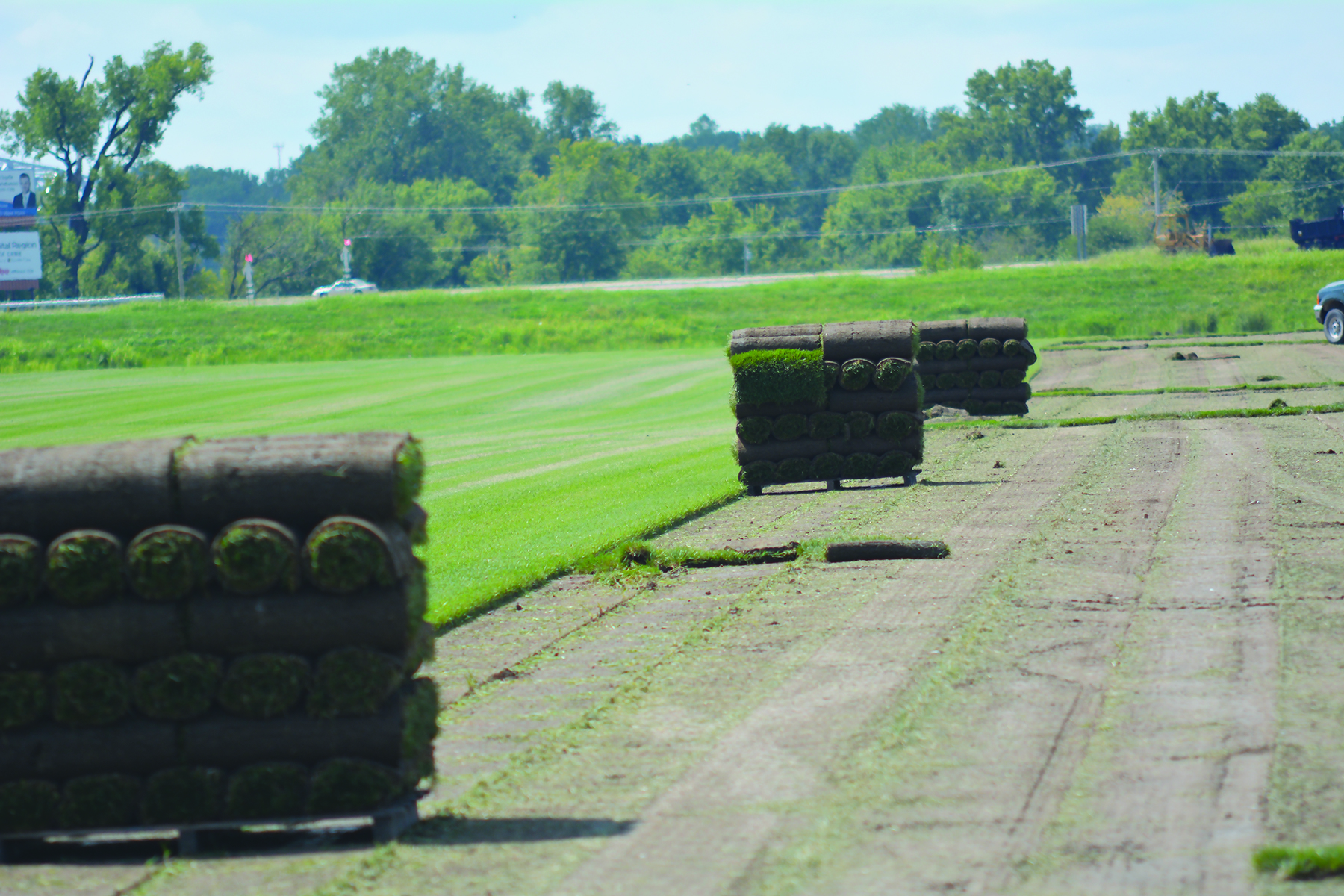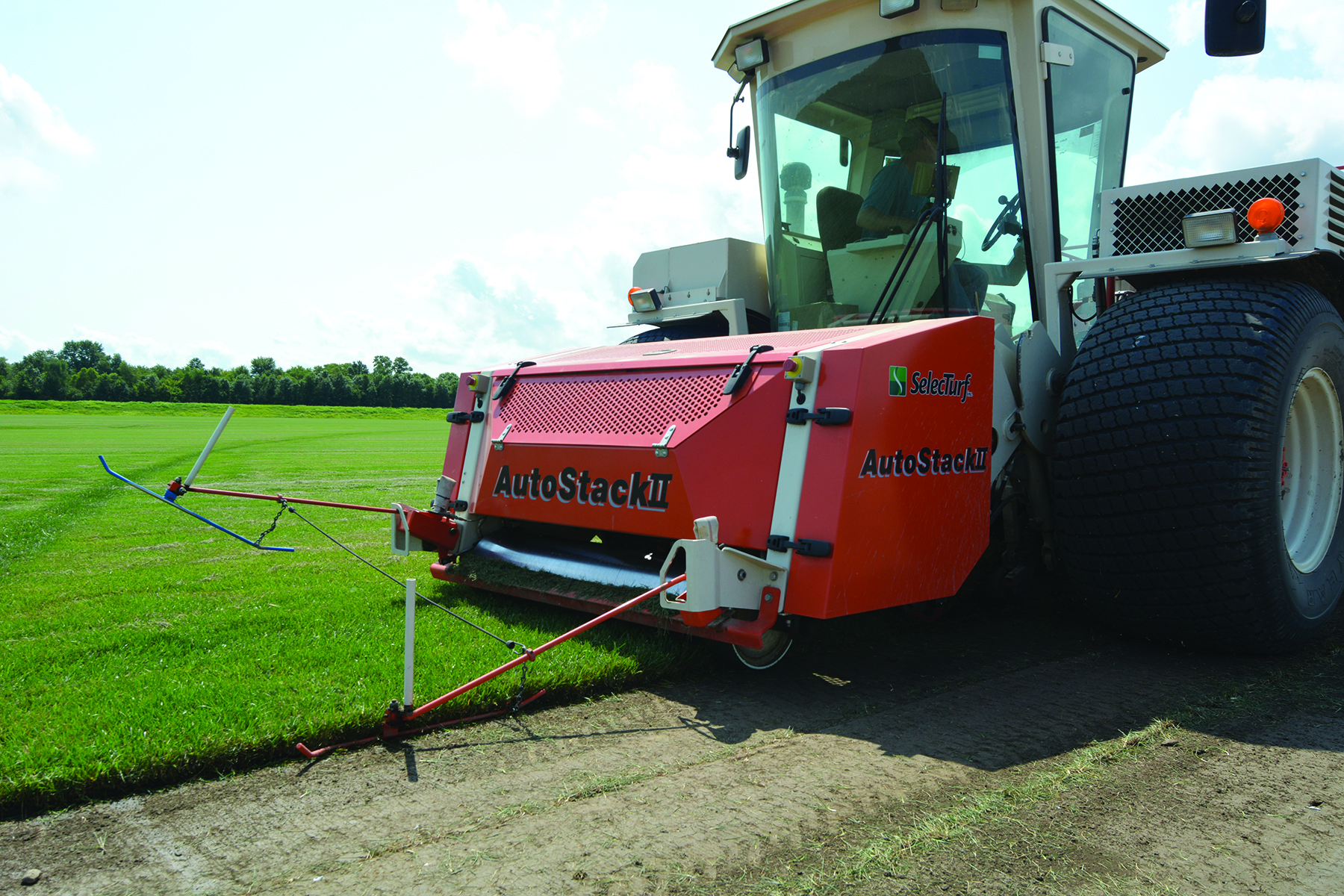Athletes and homeowners alike benefit from these green fields.
Story by Courtney Guffey. Photos by Chris Fennewald
The farm of Jim Keeven is surrounded on three sides by soccer fields, baseball fields and a golf course on the Missouri River bottoms within sight of the State Capitol. It is an appropriate setting for Keeven, who is a turf farmer. His fields literally look like part of some outdoor sports complex. The grass may well be destined for a sports venue elsewhere once it is harvested. Growing turf, or sod, for sports fields and home lawns is Keeven’s livelihood. Jim, his wife Kathy, their family and eight full-time employees grow, harvest and deliver turf.
Operating as SelecTurf for 33 years, Keeven has been in the sod industry long enough to know the ins and outs of raising this natural outdoor carpet. The business was originally started by his parents, Ed and Vivienne, in 1951 as a sod installation company in Florissant, Missouri. Twelve years later, they relocated to O’Fallon. After focusing their efforts on growing premium turf, the business turned its attention to wholesale sod sales. In 1984, Jim and two of his brothers bought the company from their parents and transformed it into Emerald View Turf Farms. Jim relocated to central Missouri in 1985 to start a new farm and in 1989, one of his brothers moved to Columbia, Illinois, to expand there. The next decade proved hard for Keeven. His new operation in the Missouri River bottom flooded every few years and he had to grow with a smaller customer base. He prevailed and in 2011, Jim and Kathy split the company from the rest of the family and now operate SelecTurf.
The 550-acre farm is dedicated mainly to three crops: Tall Fescue, Zoysia and Bluegrass. While the majority of their customers are residential, about 25 percent of their business comes from commercial buyers, such as golf courses and athletic fields. “Residential is by far the biggest part, it consumes 75 percent of my daily work. As long as they are building homes, I’ll stay busy,” Keeven says. They work with landscapers and homeowners who install the sod, but Keeven and his crew focus on cutting and deliveries. Sometimes this means cutting or harvesting at 3 a.m. to have sod at the installation site by 7 a.m. “We grow it, put our expertise there and let other people install it”
He says most of their business is in mid-Missouri. “We mainly deal with three areas, Jefferson City, Columbia and anywhere around the Lake of the Ozarks. We do range out further than that, making runs to Springfield and Kirksville. We had trucks in Kansas City two to three times a week last year, mostly for golf courses. My day-to-day area is right here in central Missouri.”
This sod farmer’s season is opposite of most farmers’. “Everything we plant goes in right around September, it takes us nine months to make a crop, but we prefer to have turf about 12 months old before we start harvesting. From seed to harvest, I normally forecast about a year,” he says. The season never stops; cutting keeps going as long as the ground will allow. The only time his crews don’t cut turf grass is when the fields are wet or frozen.
After the seed is planted, it goes into a dormant mode over the winter and comes to life in the spring. Keeven schedules at least half of the farm in turf grass going into the winter so there is plenty of work for his crew in the spring. “We cut sod every day, except Sundays, a day off for us. We fill orders in the evenings to get on trucks and out for delivery. If it gets too warm, we’ll cut early in the morning.”
Irrigation pivots and reel hose irrigators are scattered across the farm. These are critical for maintaining a healthy crop. “We have five center pivots on the farm. Anything that can’t be hit by a pivot gets picked up by hard hose reels. We try to irrigate everything we have. That’s the best way to grow grass, that’s what keeps it going all summer.”
The grass is mowed every five days to keep it at optimal height for transplanting. Broadleaf chemicals and insecticides are used only when needed, and fungicide is sprayed about once a month on a preventative basis.
One herbicide Keeven avoids is Dicamba, although it is very effective in turf grass. “I don’t use it, but it can kill clover like none other. I get a little leery because I have a lot of neighbors that grow soybeans.” Jim says they carefully follow label instructions on every chemical used and never overspray.
Weather determines when Keeven sprays, but irrigation adds some control and helps limit the amount of chemicals used when they are needed. Irrigation also makes fertilizer and organic materials more effective. SelecTurf is experimenting with chicken litter compost and the soil is responding well. Keeven hopes to expand compost use over the entire farm.
Even though Keeven is an experienced farmer, he faces issues familiar to many farmers. “I’ve been here for 33 years and something I’ve always struggled with is ground availability. Land just doesn’t change hands very often. I have been fortunate to be able to build these 550 acres, all pretty much touching. It’s taken a lot of time to do that and a lot of patience,” Keeven says.

His Missouri River bottom ground is prime farmland well-suited for growing turf, but the location is prone to flooding. The 1993 and 1995 floods nearly wiped him out.
“It’s not if it’s going to flood, it’s when it’s going to flood,” he says. “That’s always one of my main concerns in the spring. We’ve been extremely fortunate since ’95 to not have any water reach here.”
Rotating crops is another management challenge. Keeven says growing turf, no matter the variety, is demanding on the soil. He replenishes the soil with a soybean crop rotation.
“It really just gives my soil a break. We didn’t plant soybeans last year because we had a tremendous amount of Japanese beetles on the farm the year before,” he says. “Knowing the life cycle of these beetles, they were looking right at my turf grass and that scared me. To try and minimalize that, we didn’t put soybeans in, but we still saw a lot of Japanese beetles.”
He is evaluatating crop rotation alternatives and annual clover may be an option if mowed to reduce seedhead production and controlled with herbicide. Like soybeans, clover is a legume that adds nitrogen to the soil.
Keeven has built up his turf farm along with his customer base. But there is one regret he has that has nothing to do with turf in particular.
“I never finished my college degree. I didn’t think they could teach me anything I didn’t already know or couldn’t learn on the farm. It bothers me because I started something and never finished. It’s so important to get your degree and to have something to fall back on,” he says.
SelecTurf began as a family company with Ed and Vivienne, and Jim hopes it will always stay that way. He plans for his son and daughter to take over the operations in as little as seven years. Both are now involved in the farm.
How it Works
The highly specialized Tebro AutoStack II machine Keeven uses can harvest about half an acre of sod an hour. The machine cuts a 4 foot swatch of sod that is sliced into 2-foot-wide, 62-inch-long rolls. Those rolls end up on a pallet dropped behind the machine. The 58 rolls per pallet equal 600 square feet of sod destined for a new lawn.
Here is a look at lawn care month-by-month by MU extension specialists Brad S. Fresenburg, Turfgrass State Specialist, and Lee Miller, Turfgrass Pathologist. Details can be found by looking up MU Extension publication G6705 online at extension.missouri.edu. These guidelines are for cool season grasses such as Kentucky bluegrass, perennial ryegrass, tall fescue and fine fescue. Timing is approximate for central Missouri, but may vary two weeks or more from one area to another in the state.
Monthly Grass Care
March
Use broadleaf herbicides for perennial and winter annual weeds not controlled in the fall. Overseed thin spots early. Before growth starts, power rake or mow to remove excess old growth. This speeds soil warming and lawn green-up. Watch and control moles. Repellents containing castor bean oil are effective. Consider a soil test.
April
Fertilize with 0.5 to 1 nitrogen per 1,000 square feet. Mow as needed. Remove excessive clippings, looking for leaf spot and mildew diseases. Aerate if thatch is heavy or soil is compacted. Use crabgrass preventers by April 15.
May
Do not apply nitrogen fertilizer, particularly soluble forms, past May 1. It encourages development of foliar diseases. Apply postemergence broadleaf herbicides for summer weeds. Start postemergence control of crabgrass, goosegrass or nutsedge near the end of the month.
Watch for sod webworms. Apply insecticides about 10 days after major moth flight.
June
Water as needed, but only enough to prevent drought stress. Overwatering can promote fungal growth. Avoid puddles and runoff. Increase mowing height by 1/2 to 1 inch if grass stand is thin. Taller mowing heights of 2 1/2 to 3 inches reduce the chance for turf scalping. Rapidly growing lawns need frequent mowing. Scout for webworm damage and treat if found. Let clippings remain unless they are excessive.
July
Continue frequent mowing. Irrigate only enough to prevent turf wilting (about 1 inch of rain or irrigation per week.) Water two to three times each week between 6 and 10 a.m. to reduce disease. Avoid frequent, daily irrigation.
Search for white grubs in brown areas. Dead turf in those areas can be peeled from the surface. If five to 10 grubs appear in 1 square foot, treat with a grub insecticide near month-end. Irrigate to move the insecticide to where grubs are active.
August
Fall seeding and sodding provides the best results, so prepare seedbed now. Plan for fall lawn renovation and purchase grass seed and fertilizer. If lawns are to be totally renovated, kill all vegetation with a glyphosate (Roundup) application near midmonth. If killing Bermuda grass, apply glyphosate on Aug. 1 and again one month later. Have soil tested if you are unsure of fertility. Soak dormant lawns in last week to start fall growth.
September
This is the most important time to fertilize. Use well-balanced lawn fertilizer to apply 1 to 11/2 pounds of nitrogen per 1,000 square feet.
Plant or sod new lawns early. Keep soil moist aerating where needed. Rake, dethatch and kill weed patches. Overseed thin spots. Resume top-dressing if needed. Late September is the best time for broadleaf herbicides, especially for perennial broadleaf weeds.
October/November
Mow at regular heights until growth stops. Apply lime if needed. Fertilize moderately after cool days. Nutrients at this time will encourage root growth and thickening of turf. Soluble nitrogen fertilizers are used more efficiently by turf in late fall. Keep leaves from packing and smothering grass. Be sure turf goes into winter with moist — not wet — soil. Use soluble fertilizer or calcium chloride instead of salt for melting winter ice.
This article originally appeared in Show Me Missouri Farm Bureau Magazine, a membership publication that covers all of the issues for members and includes interesting features, opinions and the latest information on benefits and services. Become a Missouri Farm Bureau member to subscribe!



